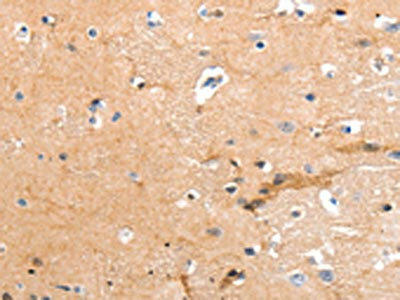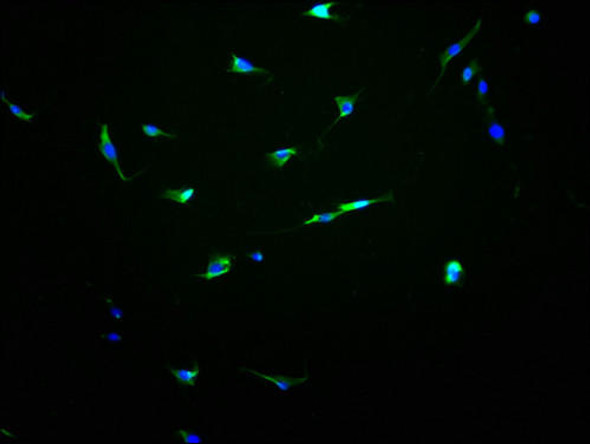Description
| Antibody Name: | GPR64 Antibody (PACO18019) |
| Antibody SKU: | PACO18019 |
| Size: | 50ul |
| Host Species: | Rabbit |
| Tested Applications: | ELISA, IHC |
| Recommended Dilutions: | ELISA:1:2000-1:10000, IHC:1:50-1:200 |
| Species Reactivity: | Human |
| Immunogen: | Synthetic peptide of human GPR64 |
| Form: | Liquid |
| Storage Buffer: | -20°C, pH7.4 PBS, 0.05% NaN3, 40% Glycerol |
| Purification Method: | Antigen affinity purification |
| Clonality: | Polyclonal |
| Isotype: | IgG |
| Conjugate: | Non-conjugated |
 | The image on the left is immunohistochemistry of paraffin-embedded Human brain tissue using PACO18019(GPR64 Antibody) at dilution 1/55, on the right is treated with synthetic peptide. (Original magnification: x200). |
| Background: | This gene encodes a member of the G protein-coupled receptor family described as an epididymis-specific transmembrane protein. The encoded protein may be proteolytically processed as it contains a motif shown to be a protein scission motif in some members of this family (PMID: 11973329). Multiple transcript variants encoding different isoforms have been found for this gene. |
| Synonyms: | G protein-coupled receptor 64 |
| UniProt Protein Function: | GPR64: Could be involved in a signal transduction pathway controlling epididymal function and male fertility. Belongs to the G-protein coupled receptor 2 family. LN-TM7 subfamily. 9 isoforms of the human protein are produced by alternative splicing.Protein type: Membrane protein, multi-pass; GPCR, family 2; Membrane protein, integral; Receptor, GPCRChromosomal Location of Human Ortholog: Xp22.13Cellular Component: cell surface; integral to plasma membrane; apical plasma membrane; integral to membraneMolecular Function: G-protein coupled receptor activityBiological Process: G-protein coupled receptor protein signaling pathway; spermatogenesis |
| UniProt Protein Details: | |
| NCBI Summary: | This gene encodes a member of the G protein-coupled receptor family described as an epididymis-specific transmembrane protein. The encoded protein may be proteolytically processed as it contains a motif shown to be a protein scission motif in some members of this family (PMID: 11973329). Multiple transcript variants encoding different isoforms have been found for this gene. [provided by RefSeq, Aug 2011] |
| UniProt Code: | Q8IZP9 |
| NCBI GenInfo Identifier: | 119943129 |
| NCBI Gene ID: | 10149 |
| NCBI Accession: | NP_005747.2 |
| UniProt Secondary Accession: | Q8IZP9,O00406, Q14CE0, Q8IWT2, Q8IZE4, Q8IZE5, Q8IZE6 Q8IZE7, B1AWB3, B1AWB4 |
| UniProt Related Accession: | Q8IZP9 |
| Molecular Weight: | 98,720 Da |
| NCBI Full Name: | G-protein coupled receptor 64 isoform 4 |
| NCBI Synonym Full Names: | G protein-coupled receptor 64 |
| NCBI Official Symbol: | GPR64 |
| NCBI Official Synonym Symbols: | HE6; EDDM6; TM7LN2 |
| NCBI Protein Information: | G-protein coupled receptor 64; epididymal protein 6; human epididymis-specific protein 6; G protein-coupled receptor, epididymis-specific (seven transmembrane family) |
| UniProt Protein Name: | G-protein coupled receptor 64 |
| UniProt Synonym Protein Names: | Human epididymis-specific protein 6; He6 |
| Protein Family: | |
| UniProt Gene Name: | GPR64 |
| UniProt Entry Name: | GPR64_HUMAN |






